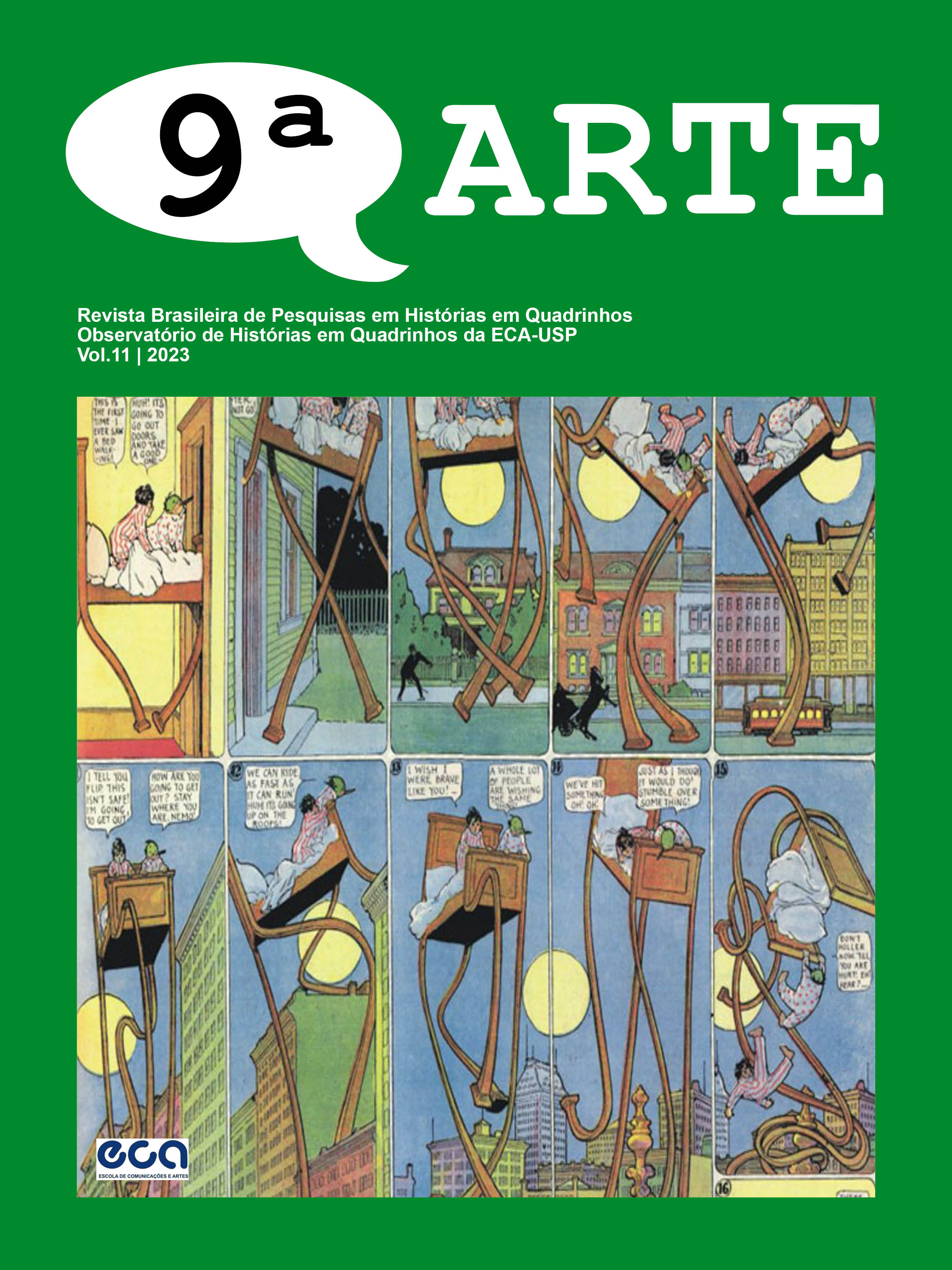Signes de ponctuation non accompagnés dans les bandes dessinées
DOI :
https://doi.org/10.11606/2316-9877.2023.v11e213371Mots-clés :
signe de ponctuation, des bandes dessinées, multimodalitéRésumé
Le point d'interrogation, le point d'exclamation et les ellipses sont des signes de ponctuation qui peuvent apparaître seuls (dans les bulles de parole, les bulles de pensée ou ancrés à l'image) dans les bandes dessinées. Notre corpus principal est formé par les bandes dessinées de Yehuda Moon & the Kickstand Cyclery car nous avons remarqué une utilisation constante de ces signes de ponctuation non accompagnés. En contrepoint, nous nous tournons vers L'essentiel Calvin et Hobbes (1988) de Bill Watterson et Dieu 1, 2 et 3 de Laerte. En contrastant ces corpus, nous percevrons des préférences ponctuelles. Cohn (2013) conçoit ces signes non accompagnés comme des upfixes (affixes), que nous discutons à partir de la formalisation des signes de ponctuation de Dahlet (2002 ; 2006) et Kleppa (2023) et de la conception de Gedin de la multimodalité dans la bande dessinée (2019 ).
##plugins.themes.default.displayStats.downloads##
Références
ABBT, Christine. Die Auslassungspunkte. Spuren subversiven Denkens. In: ABBT, C.; KAMMASCH, T. (org.). Punkt, Punkt, Komma, Strich? Geste, Gestalt und Bedeutung philisophischer Zeichensetzung. Bielefeld: Transcript Verlag, 2009. p. 101 - 116.
BELL, J. L. Wave, Toss: another way to show movement. Oz and Ends [Blogger]. Publicado em: 25 jan. 2008. Disponível em: https://ozandends.blogspot.com/2008/01/wave-toss-another-way-to-show-movement.html. Acesso em: 01 maio de 2023.
BREDEL, Ursula. Interpunktion. Heidelberg: Universitätsverlag Heidelberg, 2020.
CIRILLO, Letizia. The pragmatics of air quotes in English academic presentations. Journal of Pragmatics, v. 142, p. 1-15, 2019.
COHN, Neil. Manga Morphology. Disponível em: https://www.visuallanguagelab.com/jvl Acesso em 05 junho de 2023.
COHN, Neil. Beyond word balloons and thought bubbles: The integration of text and image. Semiotica, v. 197, p. 35-63, 2013.
COHN, Neil; MURTHY, Beena; FOULSHAM, Tom. Meaning above the head: combinatorial constraints on the visual vocabulary of comics. Journal of Cognitive Psychology, vol. 28, n. 5, p. 559-574, 2016. DOI: http://dx.doi.org/10.1080/20445911.2016.1179314. Acesso em 17 junho 2023.
CRYSTAL, David. Making a point: the pernickety story of English punctuation. London: Profile Books, 2015.
DAHLET, Véronique. A pontuação e sua metalinguagem gramatical. Revista de Estudos da Linguagem, Belo Horizonte, v. 10, n.1, p. 29-41, 2002.
DAHLET, Véronique. As (man)obras da pontuação. Usos e significações. 1. ed. São Paulo: Associação Editorial Humanitas / Fapesp, 2006.
DÜRRENMATT, Jacques. From invisibility to visibility and backwards: punctuation in comics. Visible Language, 45. ½, p. 20-43, 2011.
FLUSSER, Vilém. ? O Estado de S. Paulo, 22 outubro de 1965.
GEDIN, David. Format codings in comics: the elusive art of punctuation. Inks, v. 3, 1.3, p. 298-314, 2019.
GREGORY, Stephan. Das Ausrufezeichen. In: LUTZ, Helga; Plath, Nils; Schmidt, Dietmar (orgs.). Satzzeichen: Szenen der Schrift. Berlin: Kultur Verlag Kadmos, 2017, p. 283-286.
KLEPPA, Lou-Ann. Onze sinais em jogo. Campinas: Editora Unicamp, 2019.
KLEPPA, Lou-Ann. Sinais de pontuação como símbolos linguísticos. Cadernos de Estudos Linguísticos, v. 65, p. e023002, 2023. DOI: 10.20396/cel.v65i.8672666. Disponível em: https://periodicos.sbu.unicamp.br/ojs/index.php/cel/article/view/8672666. Acesso em: 17 jun. 2023.
LAERTE. Deus segundo Laerte. São Paulo: Olho D’água, [2000] 2005.
LAERTE. Deus 2: a graça continua. São Paulo: Olho D’água, [2002] 2003. (A)
LAERTE. Deus 3: a missão. São Paulo: Olho D’água, 2003. (B)
MESQUITA PRESTES, Maria Luci de. A estrutura frasal e a pontuação nos diálogos de histórias em quadrinhos publicadas no Brasil. COLOQUIO ARGENTINO DE LA IADA, 2º, 2005. Actas. La Plata: Universidad Nacional de La Plata, 2005. p. 524-538. Disponível em: http://sedici.unlp.edu.ar/handle/10915/115081. Acesso em: 09 out. 2023.
NUNBERG, Geoffrey. The linguistics of punctuation. Center for the Study of Language and Information. Leland Stanford Junior University, 1990.
PIEKOS, Nate. Comic Book Grammar and Tradition. Blambot: Comic Fonts and Lettering. [Homepage] Publicado em: 2009. Disponível em: http://www.blambot.com. Acesso em 15, jun. 2023.
SMITH, Rick. Yehuda Moon and the Kickstand Cyclery 1: life on a bicycle. Ontario: Kickstand Cyclery, 2011.
SMITH, Rick; GRIGGS, Brian. Yehuda Moon and the Kickstand Cyclery 2: saddle stories. Ontario: Kickstand Cyclery, 2012. (A)
SMITH, Rick; GRIGGS, Brian. Yehuda Moon and the Kickstand Cyclery 3: spin on by. Ontario: Kickstand Cyclery, 2012. (B)
SMITH, Rick; GRIGGS, Brian. Yehuda Moon and the Kickstand Cyclery 4: keep ‘em rollin’. Ontario: Kickstand Cyclery, 2012. (C)
SMITH, Rick; GRIGGS, Brian. Yehuda Moon and the Kickstand Cyclery 5: new bike day. Ontario: Kickstand Cyclery, 2013.
SMITH, Rick; GRIGGS, Brian. Yehuda Moon and the Kickstand Cyclery 6: round the bend. Ontario: Kickstand Cyclery, 2016.
WATTERSON, Bill. The essential Calvin and Hobbes. Kansas City: Andrews and McMeel, 1988.
Téléchargements
Publiée
Numéro
Rubrique
Licence
(c) Copyright 9ª Arte (São Paulo) 2023

Ce travail est disponible sous la licence Creative Commons Attribution 4.0 International .

Este obra está licenciado com uma Licença Creative Commons Atribuição 4.0 Internacional.



 Este obra está licenciada com uma Licença
Este obra está licenciada com uma Licença 